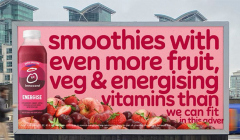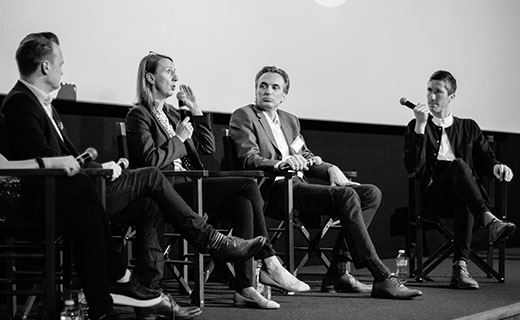
Innocent campaign is jam-packed with goodness
Neverland helps bring to life the amount of fruit, veg and vitamins in Innocent smoothies and juices

Using our survey as a springboard, we asked our panellists whether they thought that over the next three years clients would gravitate increasingly towards a ‘full service’ model from agencies. It seems a logical step – if there are agencies who can deliver this brilliantly well, is it not a no-brainer for clients to work to that model? Or are there reasons why clients might not want to? Jennelle Tilling of KFC says this would sacrifice the “diversity of ideas; of what they can bring to the table” that you get from a roster of separate agencies. She continued: “Giving all my work to one agency – that’s dangerous to me. I believe in diversity of ideas.” Lisa Wood from Atom Bank elaborated on Jennelle’s point, saying “It would be ideal to work with just one agency and be so closely aligned to them. But I just don’t think it’s possible.
Jennelle Tilling said that “we’re always going to be impatient as clients.” This certainly drew its share of like-minded murmurs from the audience as we discussed the pace of delivery from agencies and how the majority of the panel considered this still to be lacking. Paul Davies from Microsoft talked about this being a result of the “gold rush for content and production.” Jeremy Ellis from TUI agreed, saying “clients have to be part of the conversation every day – to be relevant. That causes a speed of turnaround like there’s never been. It’s a constant conversation.” Lisa Wood from Atom Bank offered one potential solution – that clients help their agencies become more agile. She said: “if there’s a looser brief, you can sometimes have more creativity … you might start with a looser brief but through the process you might get to a much more defined idea of what you want to put out there.” Jennelle agreed, saying “sometimes the looser brief is better. So long as you’re very clear what your brand world is … I encourage the team to get the agency really immersed in what the brand world is and then let them go.” Lisa Wood even said “A lot of the slowing down is because we haven’t been clear or up front with what we’re trying to achieve with the agency. And that’s because of speed and thinking time.” Jennelle agreed, adding that “the turnaround on content isn’t 24 hours; it’s 3 or 4 hours.” As Lisa commented, “The traditional creative process, you don’t have time for anymore.”
When talking about the relationship between brands and agencies, Paul Davies from Microsoft wondered “whether as clients we ask too much of our agencies.” If anything was up for discussion at the event, it was what exactly clients want from their agencies. Lisa Wood from Atom Bank struck at the divide between brands and agencies, saying “more and more of what you need from an agency is an extension of your own team.” Paul Davies sees the relationship as a two-way value exchange. As the conversation moved to remuneration, the sentiment of close alignment remained the same. Jennelle Tilling said that at KFC specific budget is set aside for agency performance bonuses. She said it made perfect sense that “if you beat your sales performance, the agencies should definitely share in that.” She went on to say that her own bonus is tethered to that of the agency – should the work fail to deliver, then it affects her as much as the agency she worked with. Paul Davies said that client-side marketers “want to work with our agencies to find these new remuneration models together rather than saying ‘Hey, here’s how we want to work.’” Whilst Lisa Wood shed some light on the unique remuneration model at Atom Bank: “We had an interesting journey to bring our agency [Mother] onboard. We wanted to make sure we had a strategic partner in the agency we worked with. At the same time, we couldn’t really afford it. When it came to the remuneration part, we said we can’t afford to pay you what you’re getting from your bigger brands but we can give you some equity. And they were absolutely up for it. It’s served us really well. When we’re successful and as we grow as a brand, they share in that success.”
Paul Davies shared that at Microsoft, there’s a line they use: “We’re drinking our own Kool-Aid.” It’s a red button to hit whenever there’s a worry their thinking is getting too insular and what they’re listening to is from their own echo chamber. His point came from the discussion surrounding in-housing and whether it’s something the panel believed they would do more of (at an increasingly strategic level) in the next three years. Lisa Wood said she didn’t believe you could in-house everything. “It can be quite self-serving,” she continued. “You don’t get that tap on the shoulder you need.” Asked if he thought there was a danger of being too close to an idea by in-housing, Jeremy Ellis said: “I totally agree with that. I walk into a boardroom with some creative ideas and inevitably the people around the table will choose what they feel most strongly about which is typically what they want us to say to consumers and not what the consumer wants to hear. It’s really important to always have an independent ratification of what that looks like.”
Clients briefing agencies on transformational ideas versus channel-specific content was the biggest point of contention between brands and agencies who filled out our survey. Jennelle Tilling said earlier in the event how “the need for big ideas is always going to be there” and on the point of transformational ideas, Paul Davies reiterated this. “We need a return to the big creative idea. I worry we’ve devalued it a bit of late.” But the panel agreed that it needed to be reined in – Jennelle clarifying that “we want transformational ideas that work. Not just ones that are great.” Yet the hurdles on what they are and how this is communicated remain. Jeremy Ellis offered his view on why the divide existed: “It’s an interpretational issue: agencies probably come back thinking what’s requested in a brief isn’t quite in the way the client is thinking it. I think we’re all after the same thing. I think the numbers say that people have interpreted it in a different way depending on which side of the fence you sit on.” Paul Davies concluded that of course “everybody wants a transformational idea. The trick is selling it up the organisation. That’s where it comes unstuck.”
Follow Creativebrief on Twitter or LinkedIn to discover need-to-know marketing trends and analysis
Looks like you need to create a Creativebrief account to perform this action.
Create account Sign inLooks like you need to create a Creativebrief account to perform this action.
Create account Sign in